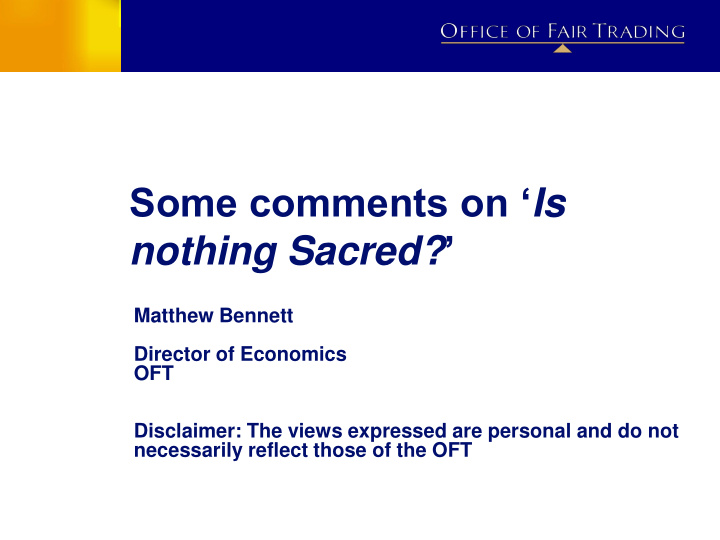



Some comments on ‘ Is nothing Sacred? ’ Matthew Bennett Director of Economics OFT Disclaimer: The views expressed are personal and do not necessarily reflect those of the OFT
Post-Leegin, US consistent with EU? ● Has Leegin taken US towards EU? That seems to assume: - US has moved to a rule of reason, and it is too soon to know interpretations. - EU interpretation of 81(3) is sufficiently broad to allow RPM to be considered outside of a per-se framework. ● Article 81(3) in hard core infringements is hardly ever accepted thus how likely is this? (6 RPM cases since 1999). ● Agree that there is room to interpret the law in theory , the real issue is whether there is an appetite to interpret the law in reality . - There is little appetite for firms to push against it if by doing so they incur significant legal costs for only a small chance of change. - There is also the question of whether courts will uphold any new policies that move away from previous interpretations of the law.
Is RPM broken? ● Is RPM broken? - Maximum price (double marginalisation) is not object offense, only minimum and fixed RPM (free riding) are object. - Not so clear that minimum and fixed RPM are essential to achieve free riding efficiencies. - More guidance to take maximum prices more explicitly out of the hard- core infringements. ● Paper asks for guidance - Guidance would be helpful. Even a discussion of thinking tends to spark debate and clarify where an authority stands on a topic. - However when guidance does not adhere strictly to the existing case law, then it becomes more problematic. - In such situations a statement of how an authority prioritises cases may provide the guidance without cutting across the case law.
Object versus effects ● Paper presents law and economics having different goals. - Two extremes presented per-se with 100% certainty and rule of reason with very little certainty. - Breyer’s statement that: "in most matters it is more important that the applicable rule of law be settled than it be settled right" . - In dissenting decision Breyer bases much of his conclusion on the principle of stare decisis rather than belief of correct decision. - Not clear that this makes for a good judgement, see for example Microsoft judgement. ● Are extremes only possibilities? In reality one can think of a continuum across these two extremes. - Screens and the use of burden of proof can provider greater certainty than effects based, but still provide better results than a per-se approach.
OFT experience ● In looking at understanding type I and type II errors it is helpful to look at (relatively limited) OFT experience: - Limited evidence on beneficial RPMs, Removal of UK Book RPM suggests benefits overstated. - Several cases against RPM consistent with anticompetitive effects. (Replica Football Kits and Toys). ● Suggests the cost of false negatives may be higher than false positives. ● Implies an ‘object’ starting point… but … it is important that this presumption is rebuttable.
Some thoughts for changes in RPM ● RPM remains an object infringement (where minimum or fixed). ● However rebuttable on basis that the presumption of harm is incorrect given the market context. - Thus based on the market there is no plausible theory of harm and there is a plausible theory of efficiencies - Moves the authorities away from bringing cases where there is no theory of harm, and there are efficiencies. ● NCA must respond to this in the decision. - Note: not a full effects case, but a debate on the rationale of the presumption of effects.
What are plausible theories of harm? ● Upstream collusion - a facilitating practice ● Upstream protection of monopoly rents - a commitment story ● Downstream collusion - a facilitating practice ● Downstream protection of rents - entry deterrence ● Dampening of system competition via interlocking relations
Key questions for theory of harm 1. Is there significant unilateral upstream market power? - If not there is unlikely to be a theory of harm regarding protecting upstream market power. 2. Are there networks of RPM agreements involving a number of upstream suppliers who account for a significant share of the upstream market? - If not there is unlikely to be a theory of harm regarding RPM facilitating upstream market coordination 3. Is the RPM agreement retailer instigated rather than instigated by the upstream supplier? - If not, unlikely to be a plausible theory of harm from RPM facilitating downstream coordination or deliberately foreclosing downstream entry.
Recommend
More recommend